An In-Depth Analysis of the Economic Performance of Singapore
VerifiedAdded on 2023/06/10
|11
|2540
|462
Report
AI Summary
This report provides a detailed analysis of Singapore's economic performance, examining key indicators such as real GDP, real GDP growth rate, and real GDP per capita from 2008 to 2018. It delves into the trends of unemployment, discussing structural, cyclical, and frictional unemployment, alongside government measures to address these issues. The report also analyzes inflation trends, differentiating between demand-pull and cost-push inflation and the measures taken by the Monetary Authority of Singapore (MAS) to maintain price stability. The analysis highlights Singapore's resilience during the global financial crisis and its subsequent economic growth. The report concludes by summarizing the factors affecting the economy's price level and the dominant forms of unemployment. The data is sourced from ceicdata.com, tradingeconomics.com, and other credible sources, providing a comprehensive overview of the nation's economic landscape.
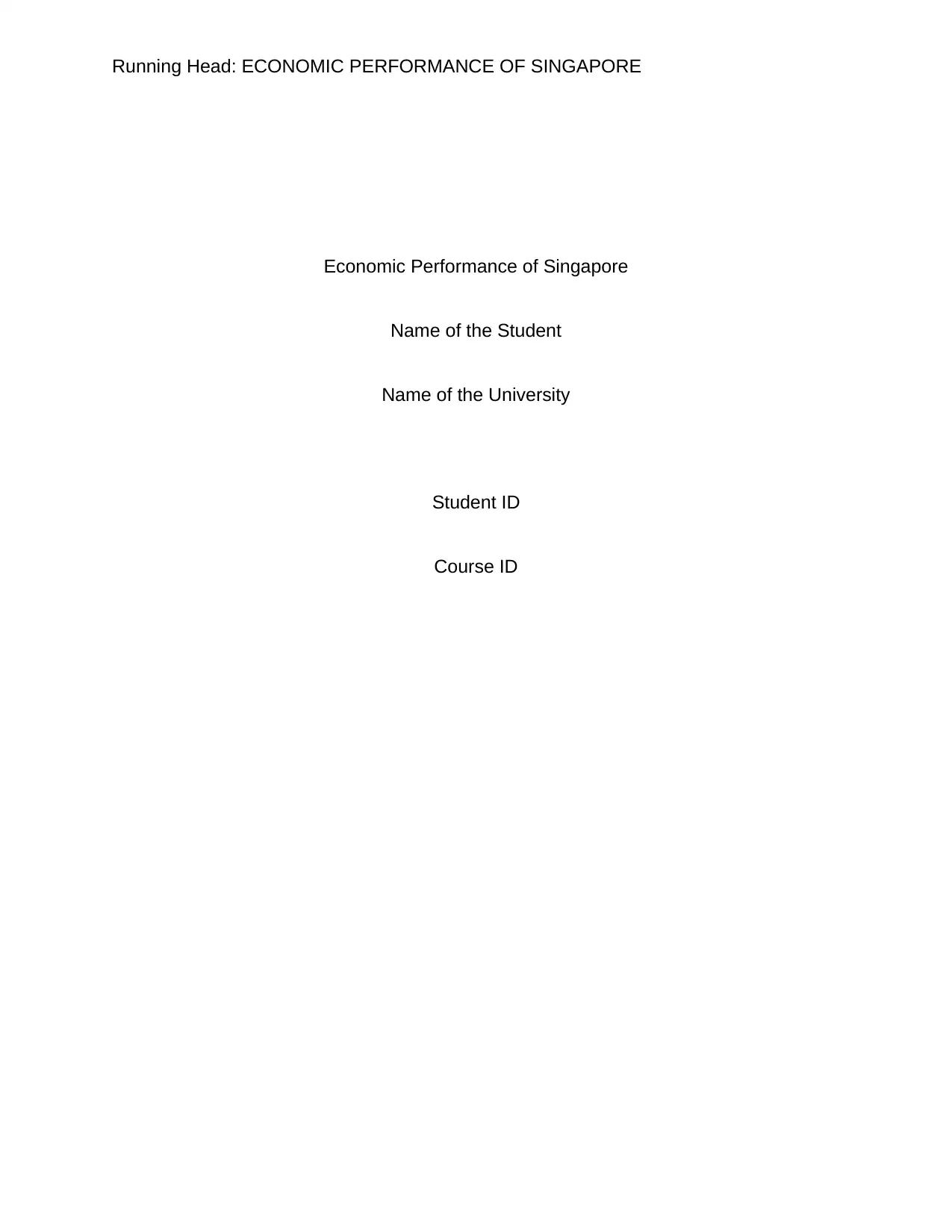
Running Head: ECONOMIC PERFORMANCE OF SINGAPORE
Economic Performance of Singapore
Name of the Student
Name of the University
Student ID
Course ID
Economic Performance of Singapore
Name of the Student
Name of the University
Student ID
Course ID
Paraphrase This Document
Need a fresh take? Get an instant paraphrase of this document with our AI Paraphraser
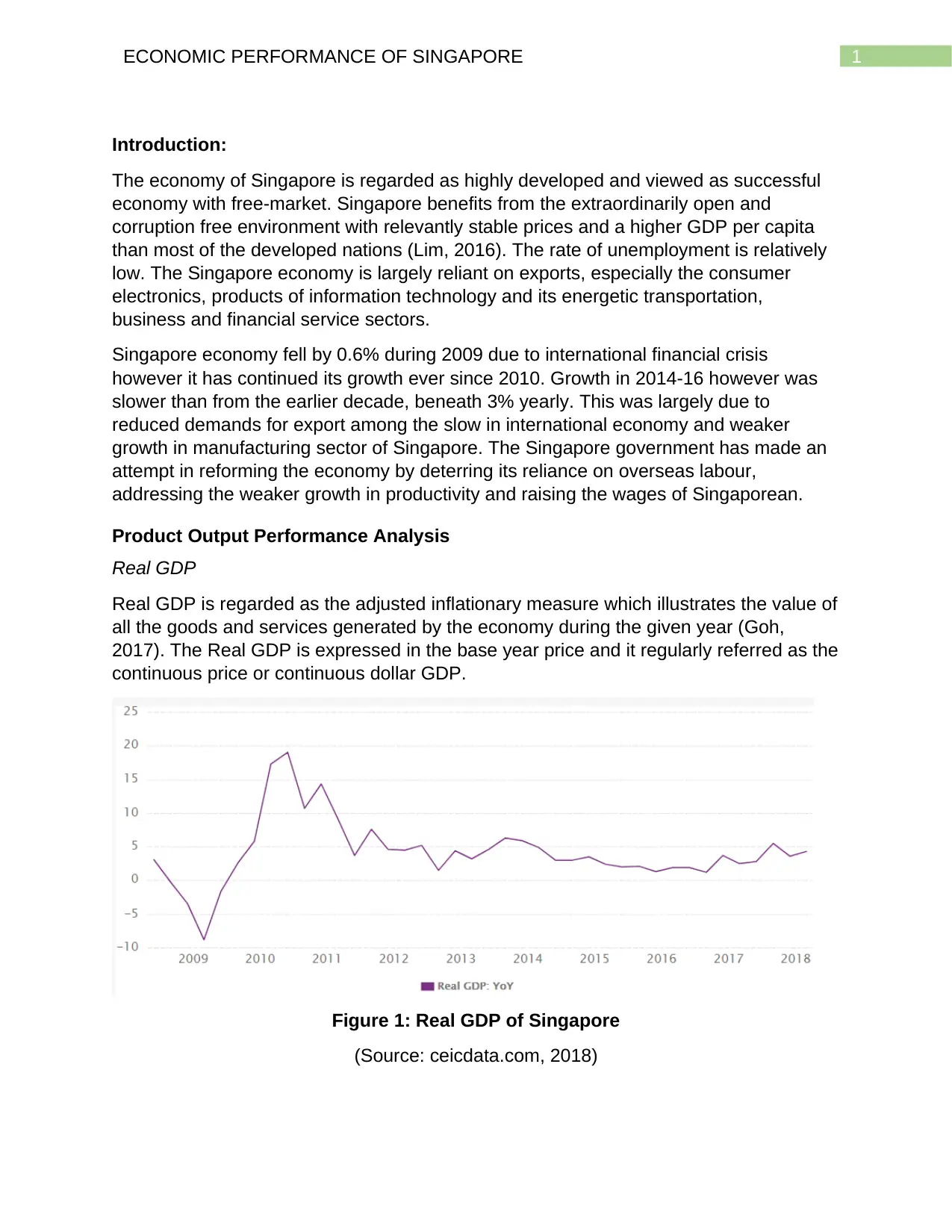
1ECONOMIC PERFORMANCE OF SINGAPORE
Introduction:
The economy of Singapore is regarded as highly developed and viewed as successful
economy with free-market. Singapore benefits from the extraordinarily open and
corruption free environment with relevantly stable prices and a higher GDP per capita
than most of the developed nations (Lim, 2016). The rate of unemployment is relatively
low. The Singapore economy is largely reliant on exports, especially the consumer
electronics, products of information technology and its energetic transportation,
business and financial service sectors.
Singapore economy fell by 0.6% during 2009 due to international financial crisis
however it has continued its growth ever since 2010. Growth in 2014-16 however was
slower than from the earlier decade, beneath 3% yearly. This was largely due to
reduced demands for export among the slow in international economy and weaker
growth in manufacturing sector of Singapore. The Singapore government has made an
attempt in reforming the economy by deterring its reliance on overseas labour,
addressing the weaker growth in productivity and raising the wages of Singaporean.
Product Output Performance Analysis
Real GDP
Real GDP is regarded as the adjusted inflationary measure which illustrates the value of
all the goods and services generated by the economy during the given year (Goh,
2017). The Real GDP is expressed in the base year price and it regularly referred as the
continuous price or continuous dollar GDP.
Figure 1: Real GDP of Singapore
(Source: ceicdata.com, 2018)
Introduction:
The economy of Singapore is regarded as highly developed and viewed as successful
economy with free-market. Singapore benefits from the extraordinarily open and
corruption free environment with relevantly stable prices and a higher GDP per capita
than most of the developed nations (Lim, 2016). The rate of unemployment is relatively
low. The Singapore economy is largely reliant on exports, especially the consumer
electronics, products of information technology and its energetic transportation,
business and financial service sectors.
Singapore economy fell by 0.6% during 2009 due to international financial crisis
however it has continued its growth ever since 2010. Growth in 2014-16 however was
slower than from the earlier decade, beneath 3% yearly. This was largely due to
reduced demands for export among the slow in international economy and weaker
growth in manufacturing sector of Singapore. The Singapore government has made an
attempt in reforming the economy by deterring its reliance on overseas labour,
addressing the weaker growth in productivity and raising the wages of Singaporean.
Product Output Performance Analysis
Real GDP
Real GDP is regarded as the adjusted inflationary measure which illustrates the value of
all the goods and services generated by the economy during the given year (Goh,
2017). The Real GDP is expressed in the base year price and it regularly referred as the
continuous price or continuous dollar GDP.
Figure 1: Real GDP of Singapore
(Source: ceicdata.com, 2018)
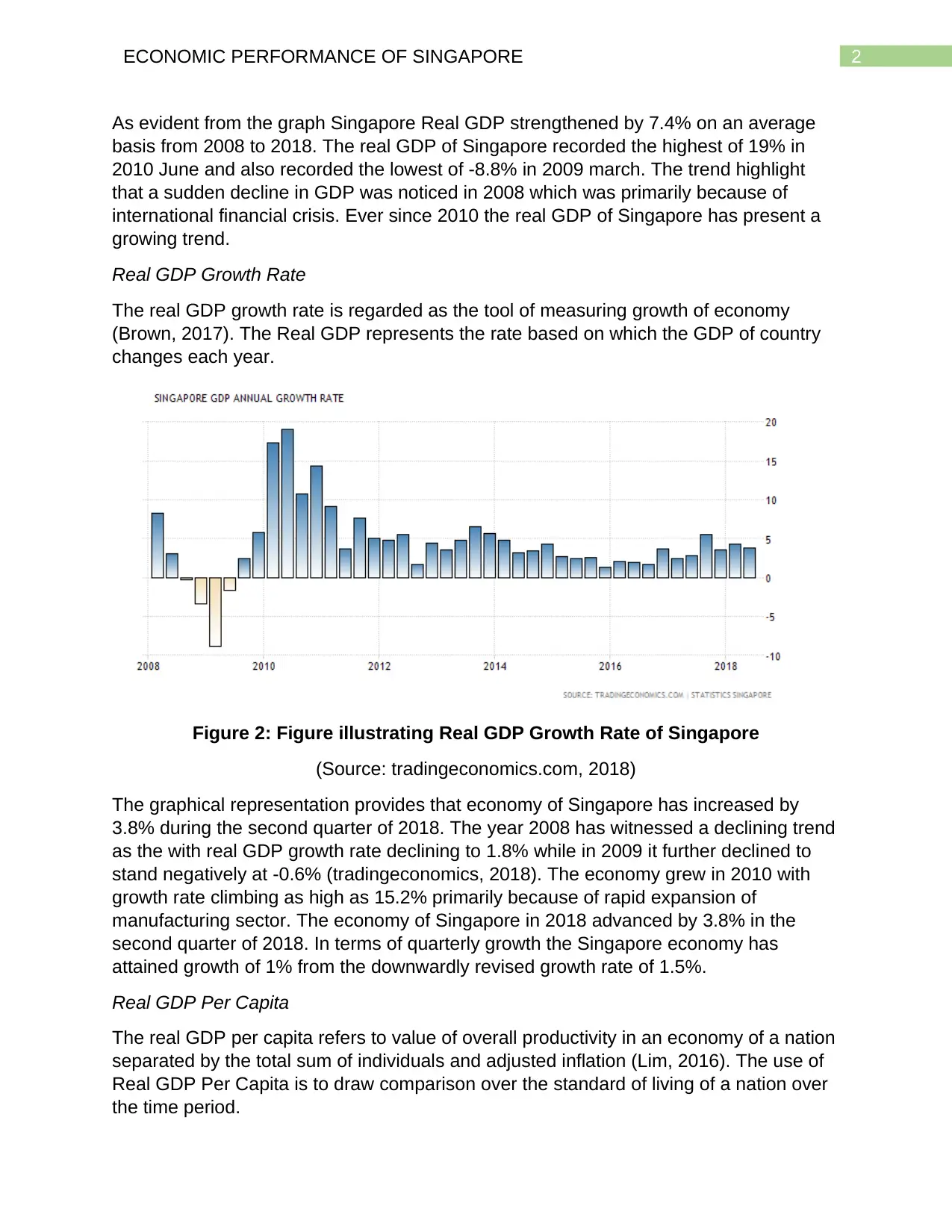
2ECONOMIC PERFORMANCE OF SINGAPORE
As evident from the graph Singapore Real GDP strengthened by 7.4% on an average
basis from 2008 to 2018. The real GDP of Singapore recorded the highest of 19% in
2010 June and also recorded the lowest of -8.8% in 2009 march. The trend highlight
that a sudden decline in GDP was noticed in 2008 which was primarily because of
international financial crisis. Ever since 2010 the real GDP of Singapore has present a
growing trend.
Real GDP Growth Rate
The real GDP growth rate is regarded as the tool of measuring growth of economy
(Brown, 2017). The Real GDP represents the rate based on which the GDP of country
changes each year.
Figure 2: Figure illustrating Real GDP Growth Rate of Singapore
(Source: tradingeconomics.com, 2018)
The graphical representation provides that economy of Singapore has increased by
3.8% during the second quarter of 2018. The year 2008 has witnessed a declining trend
as the with real GDP growth rate declining to 1.8% while in 2009 it further declined to
stand negatively at -0.6% (tradingeconomics, 2018). The economy grew in 2010 with
growth rate climbing as high as 15.2% primarily because of rapid expansion of
manufacturing sector. The economy of Singapore in 2018 advanced by 3.8% in the
second quarter of 2018. In terms of quarterly growth the Singapore economy has
attained growth of 1% from the downwardly revised growth rate of 1.5%.
Real GDP Per Capita
The real GDP per capita refers to value of overall productivity in an economy of a nation
separated by the total sum of individuals and adjusted inflation (Lim, 2016). The use of
Real GDP Per Capita is to draw comparison over the standard of living of a nation over
the time period.
As evident from the graph Singapore Real GDP strengthened by 7.4% on an average
basis from 2008 to 2018. The real GDP of Singapore recorded the highest of 19% in
2010 June and also recorded the lowest of -8.8% in 2009 march. The trend highlight
that a sudden decline in GDP was noticed in 2008 which was primarily because of
international financial crisis. Ever since 2010 the real GDP of Singapore has present a
growing trend.
Real GDP Growth Rate
The real GDP growth rate is regarded as the tool of measuring growth of economy
(Brown, 2017). The Real GDP represents the rate based on which the GDP of country
changes each year.
Figure 2: Figure illustrating Real GDP Growth Rate of Singapore
(Source: tradingeconomics.com, 2018)
The graphical representation provides that economy of Singapore has increased by
3.8% during the second quarter of 2018. The year 2008 has witnessed a declining trend
as the with real GDP growth rate declining to 1.8% while in 2009 it further declined to
stand negatively at -0.6% (tradingeconomics, 2018). The economy grew in 2010 with
growth rate climbing as high as 15.2% primarily because of rapid expansion of
manufacturing sector. The economy of Singapore in 2018 advanced by 3.8% in the
second quarter of 2018. In terms of quarterly growth the Singapore economy has
attained growth of 1% from the downwardly revised growth rate of 1.5%.
Real GDP Per Capita
The real GDP per capita refers to value of overall productivity in an economy of a nation
separated by the total sum of individuals and adjusted inflation (Lim, 2016). The use of
Real GDP Per Capita is to draw comparison over the standard of living of a nation over
the time period.
⊘ This is a preview!⊘
Do you want full access?
Subscribe today to unlock all pages.

Trusted by 1+ million students worldwide
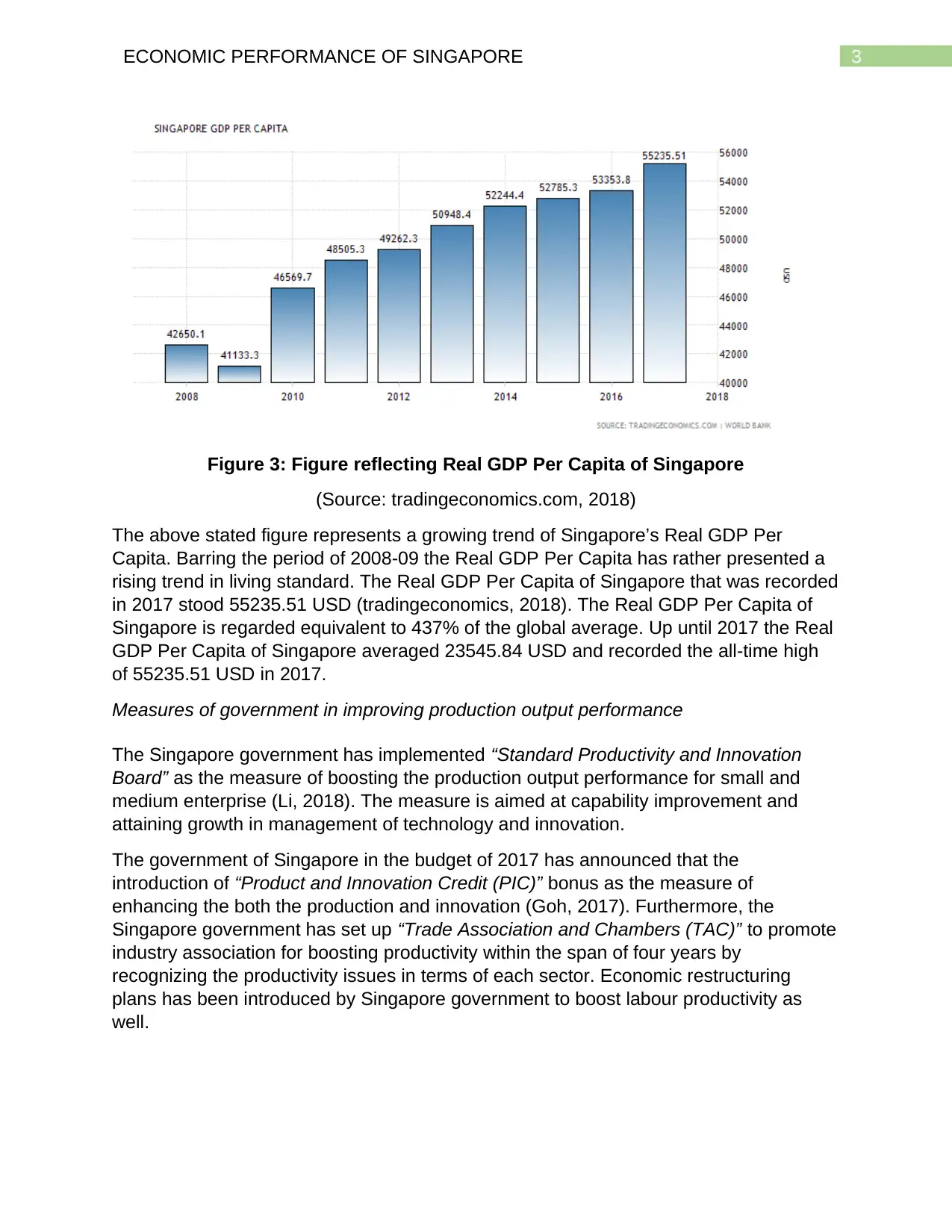
3ECONOMIC PERFORMANCE OF SINGAPORE
Figure 3: Figure reflecting Real GDP Per Capita of Singapore
(Source: tradingeconomics.com, 2018)
The above stated figure represents a growing trend of Singapore’s Real GDP Per
Capita. Barring the period of 2008-09 the Real GDP Per Capita has rather presented a
rising trend in living standard. The Real GDP Per Capita of Singapore that was recorded
in 2017 stood 55235.51 USD (tradingeconomics, 2018). The Real GDP Per Capita of
Singapore is regarded equivalent to 437% of the global average. Up until 2017 the Real
GDP Per Capita of Singapore averaged 23545.84 USD and recorded the all-time high
of 55235.51 USD in 2017.
Measures of government in improving production output performance
The Singapore government has implemented “Standard Productivity and Innovation
Board” as the measure of boosting the production output performance for small and
medium enterprise (Li, 2018). The measure is aimed at capability improvement and
attaining growth in management of technology and innovation.
The government of Singapore in the budget of 2017 has announced that the
introduction of “Product and Innovation Credit (PIC)” bonus as the measure of
enhancing the both the production and innovation (Goh, 2017). Furthermore, the
Singapore government has set up “Trade Association and Chambers (TAC)” to promote
industry association for boosting productivity within the span of four years by
recognizing the productivity issues in terms of each sector. Economic restructuring
plans has been introduced by Singapore government to boost labour productivity as
well.
Figure 3: Figure reflecting Real GDP Per Capita of Singapore
(Source: tradingeconomics.com, 2018)
The above stated figure represents a growing trend of Singapore’s Real GDP Per
Capita. Barring the period of 2008-09 the Real GDP Per Capita has rather presented a
rising trend in living standard. The Real GDP Per Capita of Singapore that was recorded
in 2017 stood 55235.51 USD (tradingeconomics, 2018). The Real GDP Per Capita of
Singapore is regarded equivalent to 437% of the global average. Up until 2017 the Real
GDP Per Capita of Singapore averaged 23545.84 USD and recorded the all-time high
of 55235.51 USD in 2017.
Measures of government in improving production output performance
The Singapore government has implemented “Standard Productivity and Innovation
Board” as the measure of boosting the production output performance for small and
medium enterprise (Li, 2018). The measure is aimed at capability improvement and
attaining growth in management of technology and innovation.
The government of Singapore in the budget of 2017 has announced that the
introduction of “Product and Innovation Credit (PIC)” bonus as the measure of
enhancing the both the production and innovation (Goh, 2017). Furthermore, the
Singapore government has set up “Trade Association and Chambers (TAC)” to promote
industry association for boosting productivity within the span of four years by
recognizing the productivity issues in terms of each sector. Economic restructuring
plans has been introduced by Singapore government to boost labour productivity as
well.
Paraphrase This Document
Need a fresh take? Get an instant paraphrase of this document with our AI Paraphraser
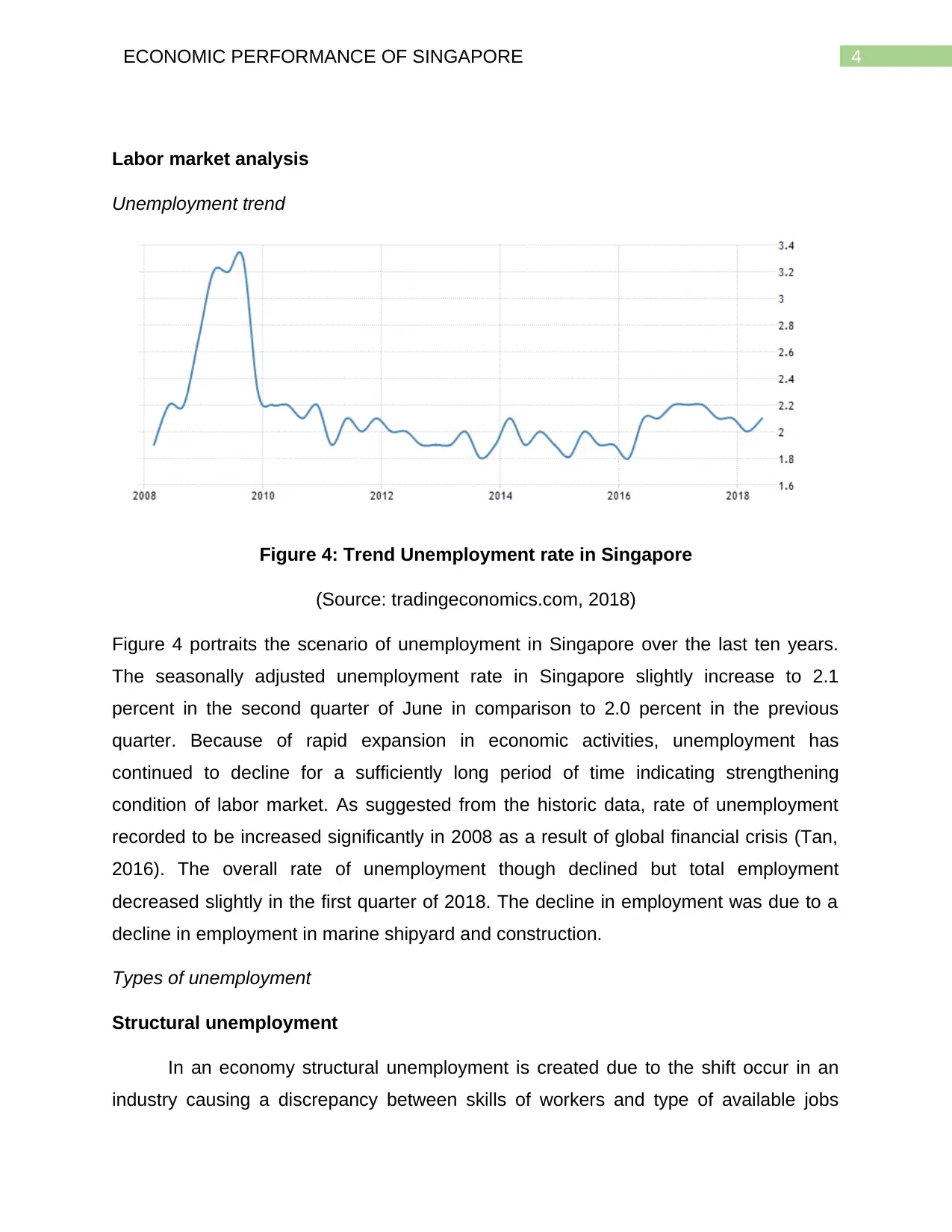
4ECONOMIC PERFORMANCE OF SINGAPORE
Labor market analysis
Unemployment trend
Figure 4: Trend Unemployment rate in Singapore
(Source: tradingeconomics.com, 2018)
Figure 4 portraits the scenario of unemployment in Singapore over the last ten years.
The seasonally adjusted unemployment rate in Singapore slightly increase to 2.1
percent in the second quarter of June in comparison to 2.0 percent in the previous
quarter. Because of rapid expansion in economic activities, unemployment has
continued to decline for a sufficiently long period of time indicating strengthening
condition of labor market. As suggested from the historic data, rate of unemployment
recorded to be increased significantly in 2008 as a result of global financial crisis (Tan,
2016). The overall rate of unemployment though declined but total employment
decreased slightly in the first quarter of 2018. The decline in employment was due to a
decline in employment in marine shipyard and construction.
Types of unemployment
Structural unemployment
In an economy structural unemployment is created due to the shift occur in an
industry causing a discrepancy between skills of workers and type of available jobs
Labor market analysis
Unemployment trend
Figure 4: Trend Unemployment rate in Singapore
(Source: tradingeconomics.com, 2018)
Figure 4 portraits the scenario of unemployment in Singapore over the last ten years.
The seasonally adjusted unemployment rate in Singapore slightly increase to 2.1
percent in the second quarter of June in comparison to 2.0 percent in the previous
quarter. Because of rapid expansion in economic activities, unemployment has
continued to decline for a sufficiently long period of time indicating strengthening
condition of labor market. As suggested from the historic data, rate of unemployment
recorded to be increased significantly in 2008 as a result of global financial crisis (Tan,
2016). The overall rate of unemployment though declined but total employment
decreased slightly in the first quarter of 2018. The decline in employment was due to a
decline in employment in marine shipyard and construction.
Types of unemployment
Structural unemployment
In an economy structural unemployment is created due to the shift occur in an
industry causing a discrepancy between skills of workers and type of available jobs
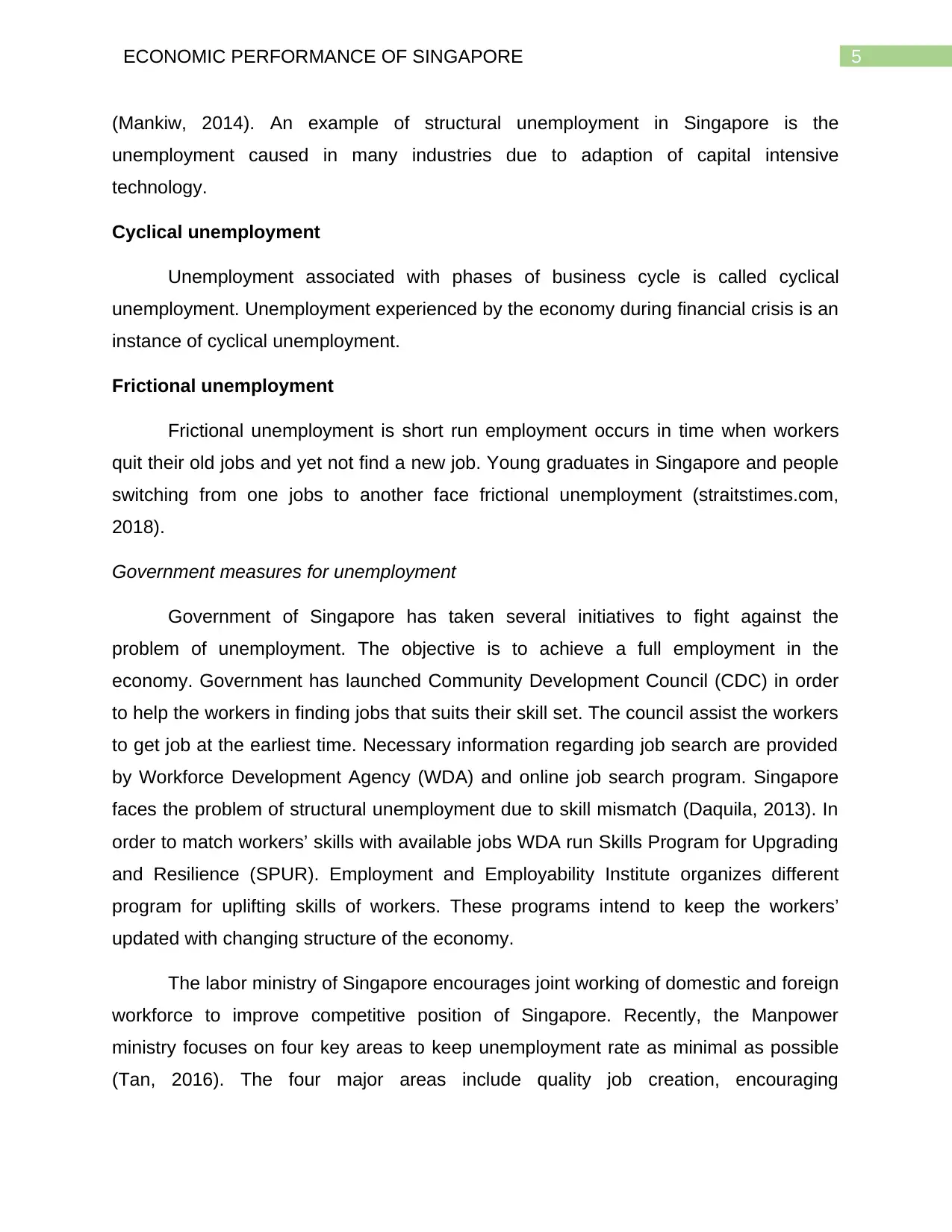
5ECONOMIC PERFORMANCE OF SINGAPORE
(Mankiw, 2014). An example of structural unemployment in Singapore is the
unemployment caused in many industries due to adaption of capital intensive
technology.
Cyclical unemployment
Unemployment associated with phases of business cycle is called cyclical
unemployment. Unemployment experienced by the economy during financial crisis is an
instance of cyclical unemployment.
Frictional unemployment
Frictional unemployment is short run employment occurs in time when workers
quit their old jobs and yet not find a new job. Young graduates in Singapore and people
switching from one jobs to another face frictional unemployment (straitstimes.com,
2018).
Government measures for unemployment
Government of Singapore has taken several initiatives to fight against the
problem of unemployment. The objective is to achieve a full employment in the
economy. Government has launched Community Development Council (CDC) in order
to help the workers in finding jobs that suits their skill set. The council assist the workers
to get job at the earliest time. Necessary information regarding job search are provided
by Workforce Development Agency (WDA) and online job search program. Singapore
faces the problem of structural unemployment due to skill mismatch (Daquila, 2013). In
order to match workers’ skills with available jobs WDA run Skills Program for Upgrading
and Resilience (SPUR). Employment and Employability Institute organizes different
program for uplifting skills of workers. These programs intend to keep the workers’
updated with changing structure of the economy.
The labor ministry of Singapore encourages joint working of domestic and foreign
workforce to improve competitive position of Singapore. Recently, the Manpower
ministry focuses on four key areas to keep unemployment rate as minimal as possible
(Tan, 2016). The four major areas include quality job creation, encouraging
(Mankiw, 2014). An example of structural unemployment in Singapore is the
unemployment caused in many industries due to adaption of capital intensive
technology.
Cyclical unemployment
Unemployment associated with phases of business cycle is called cyclical
unemployment. Unemployment experienced by the economy during financial crisis is an
instance of cyclical unemployment.
Frictional unemployment
Frictional unemployment is short run employment occurs in time when workers
quit their old jobs and yet not find a new job. Young graduates in Singapore and people
switching from one jobs to another face frictional unemployment (straitstimes.com,
2018).
Government measures for unemployment
Government of Singapore has taken several initiatives to fight against the
problem of unemployment. The objective is to achieve a full employment in the
economy. Government has launched Community Development Council (CDC) in order
to help the workers in finding jobs that suits their skill set. The council assist the workers
to get job at the earliest time. Necessary information regarding job search are provided
by Workforce Development Agency (WDA) and online job search program. Singapore
faces the problem of structural unemployment due to skill mismatch (Daquila, 2013). In
order to match workers’ skills with available jobs WDA run Skills Program for Upgrading
and Resilience (SPUR). Employment and Employability Institute organizes different
program for uplifting skills of workers. These programs intend to keep the workers’
updated with changing structure of the economy.
The labor ministry of Singapore encourages joint working of domestic and foreign
workforce to improve competitive position of Singapore. Recently, the Manpower
ministry focuses on four key areas to keep unemployment rate as minimal as possible
(Tan, 2016). The four major areas include quality job creation, encouraging
⊘ This is a preview!⊘
Do you want full access?
Subscribe today to unlock all pages.

Trusted by 1+ million students worldwide
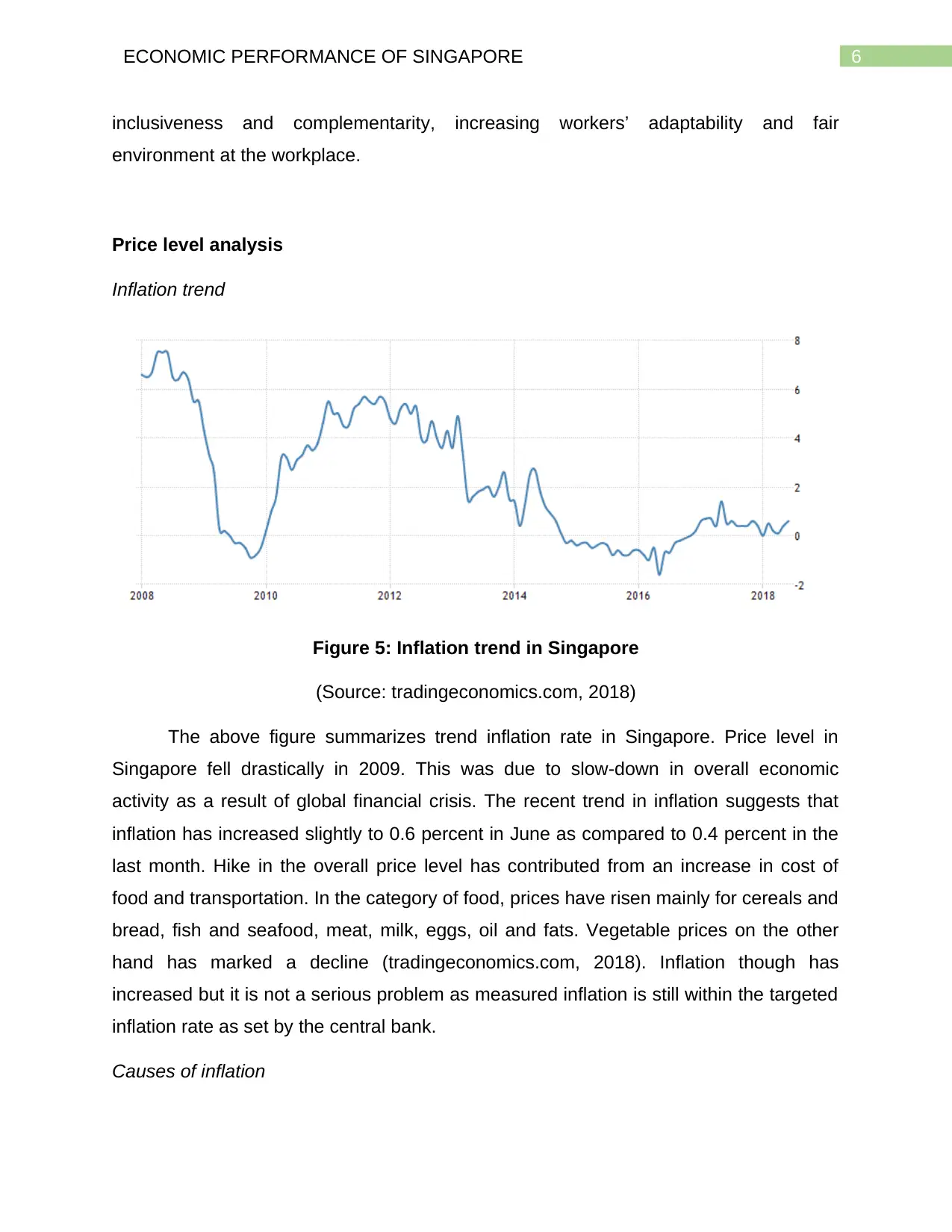
6ECONOMIC PERFORMANCE OF SINGAPORE
inclusiveness and complementarity, increasing workers’ adaptability and fair
environment at the workplace.
Price level analysis
Inflation trend
Figure 5: Inflation trend in Singapore
(Source: tradingeconomics.com, 2018)
The above figure summarizes trend inflation rate in Singapore. Price level in
Singapore fell drastically in 2009. This was due to slow-down in overall economic
activity as a result of global financial crisis. The recent trend in inflation suggests that
inflation has increased slightly to 0.6 percent in June as compared to 0.4 percent in the
last month. Hike in the overall price level has contributed from an increase in cost of
food and transportation. In the category of food, prices have risen mainly for cereals and
bread, fish and seafood, meat, milk, eggs, oil and fats. Vegetable prices on the other
hand has marked a decline (tradingeconomics.com, 2018). Inflation though has
increased but it is not a serious problem as measured inflation is still within the targeted
inflation rate as set by the central bank.
Causes of inflation
inclusiveness and complementarity, increasing workers’ adaptability and fair
environment at the workplace.
Price level analysis
Inflation trend
Figure 5: Inflation trend in Singapore
(Source: tradingeconomics.com, 2018)
The above figure summarizes trend inflation rate in Singapore. Price level in
Singapore fell drastically in 2009. This was due to slow-down in overall economic
activity as a result of global financial crisis. The recent trend in inflation suggests that
inflation has increased slightly to 0.6 percent in June as compared to 0.4 percent in the
last month. Hike in the overall price level has contributed from an increase in cost of
food and transportation. In the category of food, prices have risen mainly for cereals and
bread, fish and seafood, meat, milk, eggs, oil and fats. Vegetable prices on the other
hand has marked a decline (tradingeconomics.com, 2018). Inflation though has
increased but it is not a serious problem as measured inflation is still within the targeted
inflation rate as set by the central bank.
Causes of inflation
Paraphrase This Document
Need a fresh take? Get an instant paraphrase of this document with our AI Paraphraser
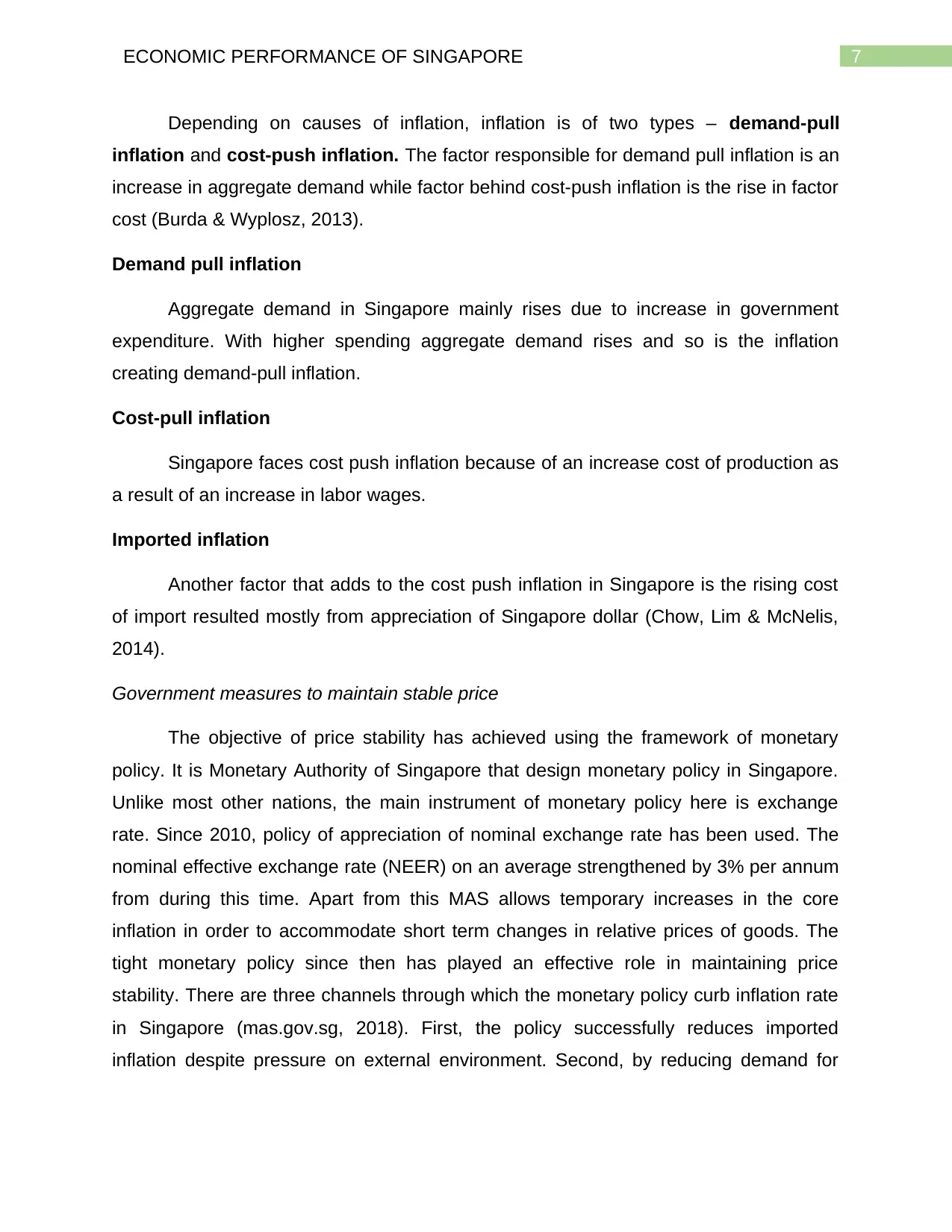
7ECONOMIC PERFORMANCE OF SINGAPORE
Depending on causes of inflation, inflation is of two types – demand-pull
inflation and cost-push inflation. The factor responsible for demand pull inflation is an
increase in aggregate demand while factor behind cost-push inflation is the rise in factor
cost (Burda & Wyplosz, 2013).
Demand pull inflation
Aggregate demand in Singapore mainly rises due to increase in government
expenditure. With higher spending aggregate demand rises and so is the inflation
creating demand-pull inflation.
Cost-pull inflation
Singapore faces cost push inflation because of an increase cost of production as
a result of an increase in labor wages.
Imported inflation
Another factor that adds to the cost push inflation in Singapore is the rising cost
of import resulted mostly from appreciation of Singapore dollar (Chow, Lim & McNelis,
2014).
Government measures to maintain stable price
The objective of price stability has achieved using the framework of monetary
policy. It is Monetary Authority of Singapore that design monetary policy in Singapore.
Unlike most other nations, the main instrument of monetary policy here is exchange
rate. Since 2010, policy of appreciation of nominal exchange rate has been used. The
nominal effective exchange rate (NEER) on an average strengthened by 3% per annum
from during this time. Apart from this MAS allows temporary increases in the core
inflation in order to accommodate short term changes in relative prices of goods. The
tight monetary policy since then has played an effective role in maintaining price
stability. There are three channels through which the monetary policy curb inflation rate
in Singapore (mas.gov.sg, 2018). First, the policy successfully reduces imported
inflation despite pressure on external environment. Second, by reducing demand for
Depending on causes of inflation, inflation is of two types – demand-pull
inflation and cost-push inflation. The factor responsible for demand pull inflation is an
increase in aggregate demand while factor behind cost-push inflation is the rise in factor
cost (Burda & Wyplosz, 2013).
Demand pull inflation
Aggregate demand in Singapore mainly rises due to increase in government
expenditure. With higher spending aggregate demand rises and so is the inflation
creating demand-pull inflation.
Cost-pull inflation
Singapore faces cost push inflation because of an increase cost of production as
a result of an increase in labor wages.
Imported inflation
Another factor that adds to the cost push inflation in Singapore is the rising cost
of import resulted mostly from appreciation of Singapore dollar (Chow, Lim & McNelis,
2014).
Government measures to maintain stable price
The objective of price stability has achieved using the framework of monetary
policy. It is Monetary Authority of Singapore that design monetary policy in Singapore.
Unlike most other nations, the main instrument of monetary policy here is exchange
rate. Since 2010, policy of appreciation of nominal exchange rate has been used. The
nominal effective exchange rate (NEER) on an average strengthened by 3% per annum
from during this time. Apart from this MAS allows temporary increases in the core
inflation in order to accommodate short term changes in relative prices of goods. The
tight monetary policy since then has played an effective role in maintaining price
stability. There are three channels through which the monetary policy curb inflation rate
in Singapore (mas.gov.sg, 2018). First, the policy successfully reduces imported
inflation despite pressure on external environment. Second, by reducing demand for
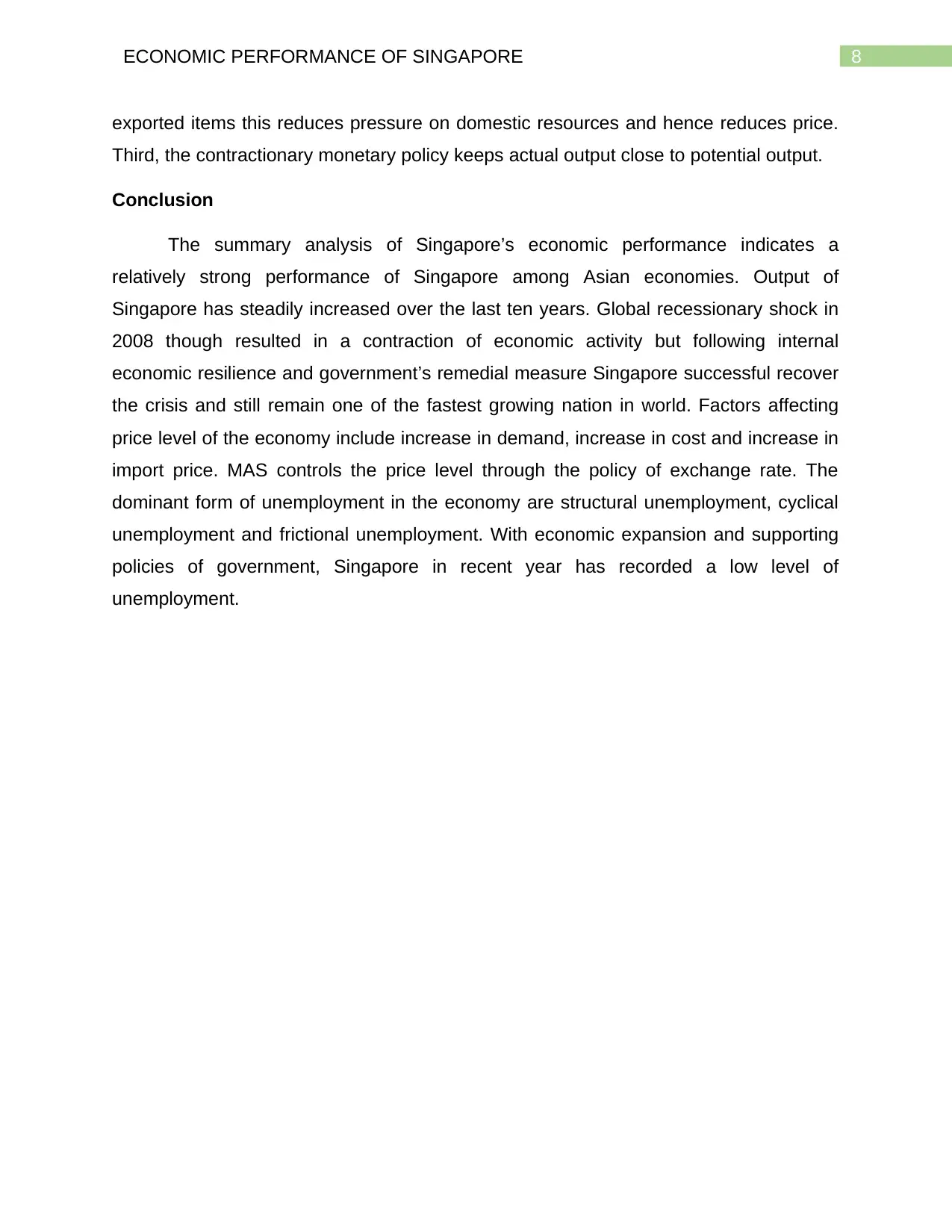
8ECONOMIC PERFORMANCE OF SINGAPORE
exported items this reduces pressure on domestic resources and hence reduces price.
Third, the contractionary monetary policy keeps actual output close to potential output.
Conclusion
The summary analysis of Singapore’s economic performance indicates a
relatively strong performance of Singapore among Asian economies. Output of
Singapore has steadily increased over the last ten years. Global recessionary shock in
2008 though resulted in a contraction of economic activity but following internal
economic resilience and government’s remedial measure Singapore successful recover
the crisis and still remain one of the fastest growing nation in world. Factors affecting
price level of the economy include increase in demand, increase in cost and increase in
import price. MAS controls the price level through the policy of exchange rate. The
dominant form of unemployment in the economy are structural unemployment, cyclical
unemployment and frictional unemployment. With economic expansion and supporting
policies of government, Singapore in recent year has recorded a low level of
unemployment.
exported items this reduces pressure on domestic resources and hence reduces price.
Third, the contractionary monetary policy keeps actual output close to potential output.
Conclusion
The summary analysis of Singapore’s economic performance indicates a
relatively strong performance of Singapore among Asian economies. Output of
Singapore has steadily increased over the last ten years. Global recessionary shock in
2008 though resulted in a contraction of economic activity but following internal
economic resilience and government’s remedial measure Singapore successful recover
the crisis and still remain one of the fastest growing nation in world. Factors affecting
price level of the economy include increase in demand, increase in cost and increase in
import price. MAS controls the price level through the policy of exchange rate. The
dominant form of unemployment in the economy are structural unemployment, cyclical
unemployment and frictional unemployment. With economic expansion and supporting
policies of government, Singapore in recent year has recorded a low level of
unemployment.
⊘ This is a preview!⊘
Do you want full access?
Subscribe today to unlock all pages.

Trusted by 1+ million students worldwide
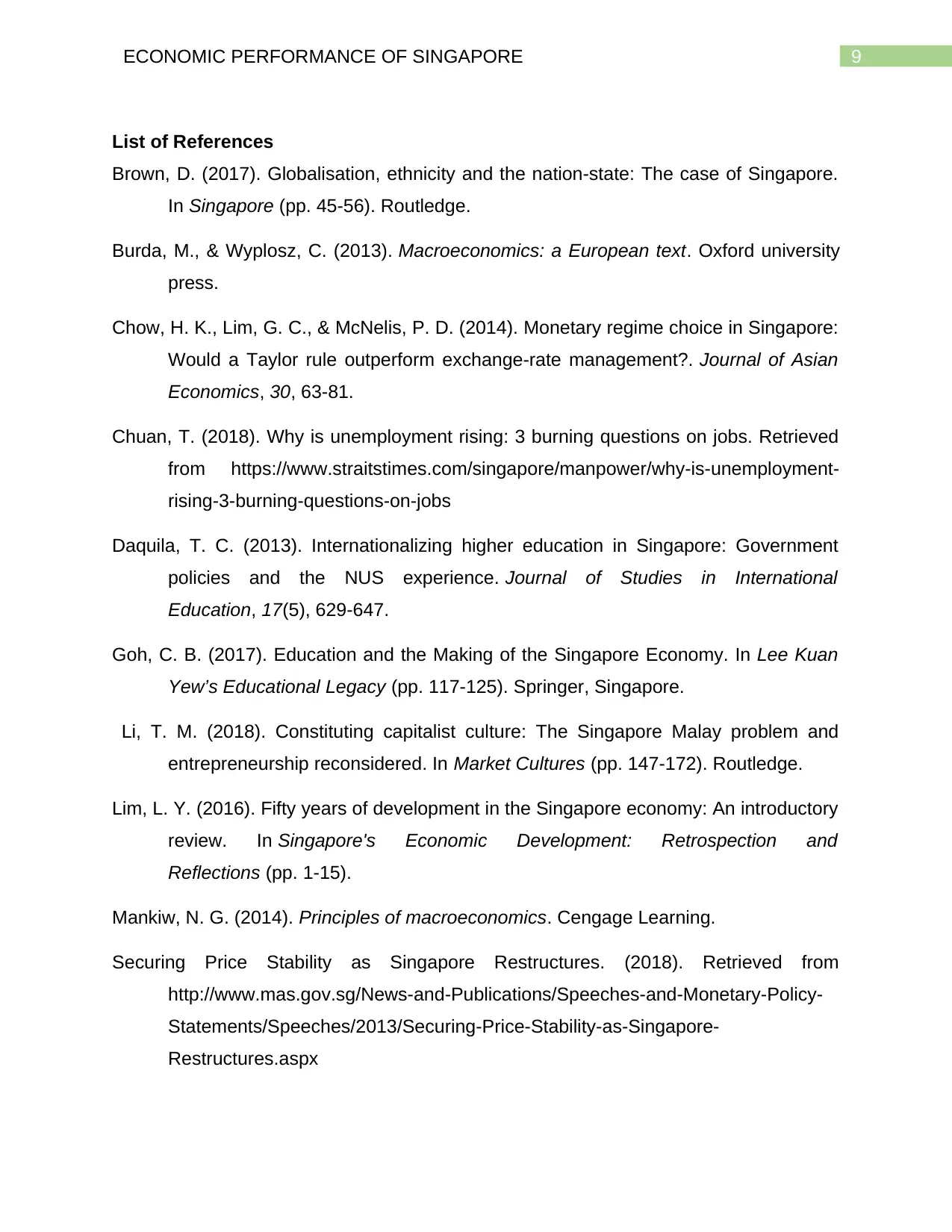
9ECONOMIC PERFORMANCE OF SINGAPORE
List of References
Brown, D. (2017). Globalisation, ethnicity and the nation-state: The case of Singapore.
In Singapore (pp. 45-56). Routledge.
Burda, M., & Wyplosz, C. (2013). Macroeconomics: a European text. Oxford university
press.
Chow, H. K., Lim, G. C., & McNelis, P. D. (2014). Monetary regime choice in Singapore:
Would a Taylor rule outperform exchange-rate management?. Journal of Asian
Economics, 30, 63-81.
Chuan, T. (2018). Why is unemployment rising: 3 burning questions on jobs. Retrieved
from https://www.straitstimes.com/singapore/manpower/why-is-unemployment-
rising-3-burning-questions-on-jobs
Daquila, T. C. (2013). Internationalizing higher education in Singapore: Government
policies and the NUS experience. Journal of Studies in International
Education, 17(5), 629-647.
Goh, C. B. (2017). Education and the Making of the Singapore Economy. In Lee Kuan
Yew’s Educational Legacy (pp. 117-125). Springer, Singapore.
Li, T. M. (2018). Constituting capitalist culture: The Singapore Malay problem and
entrepreneurship reconsidered. In Market Cultures (pp. 147-172). Routledge.
Lim, L. Y. (2016). Fifty years of development in the Singapore economy: An introductory
review. In Singapore's Economic Development: Retrospection and
Reflections (pp. 1-15).
Mankiw, N. G. (2014). Principles of macroeconomics. Cengage Learning.
Securing Price Stability as Singapore Restructures. (2018). Retrieved from
http://www.mas.gov.sg/News-and-Publications/Speeches-and-Monetary-Policy-
Statements/Speeches/2013/Securing-Price-Stability-as-Singapore-
Restructures.aspx
List of References
Brown, D. (2017). Globalisation, ethnicity and the nation-state: The case of Singapore.
In Singapore (pp. 45-56). Routledge.
Burda, M., & Wyplosz, C. (2013). Macroeconomics: a European text. Oxford university
press.
Chow, H. K., Lim, G. C., & McNelis, P. D. (2014). Monetary regime choice in Singapore:
Would a Taylor rule outperform exchange-rate management?. Journal of Asian
Economics, 30, 63-81.
Chuan, T. (2018). Why is unemployment rising: 3 burning questions on jobs. Retrieved
from https://www.straitstimes.com/singapore/manpower/why-is-unemployment-
rising-3-burning-questions-on-jobs
Daquila, T. C. (2013). Internationalizing higher education in Singapore: Government
policies and the NUS experience. Journal of Studies in International
Education, 17(5), 629-647.
Goh, C. B. (2017). Education and the Making of the Singapore Economy. In Lee Kuan
Yew’s Educational Legacy (pp. 117-125). Springer, Singapore.
Li, T. M. (2018). Constituting capitalist culture: The Singapore Malay problem and
entrepreneurship reconsidered. In Market Cultures (pp. 147-172). Routledge.
Lim, L. Y. (2016). Fifty years of development in the Singapore economy: An introductory
review. In Singapore's Economic Development: Retrospection and
Reflections (pp. 1-15).
Mankiw, N. G. (2014). Principles of macroeconomics. Cengage Learning.
Securing Price Stability as Singapore Restructures. (2018). Retrieved from
http://www.mas.gov.sg/News-and-Publications/Speeches-and-Monetary-Policy-
Statements/Speeches/2013/Securing-Price-Stability-as-Singapore-
Restructures.aspx
Paraphrase This Document
Need a fresh take? Get an instant paraphrase of this document with our AI Paraphraser
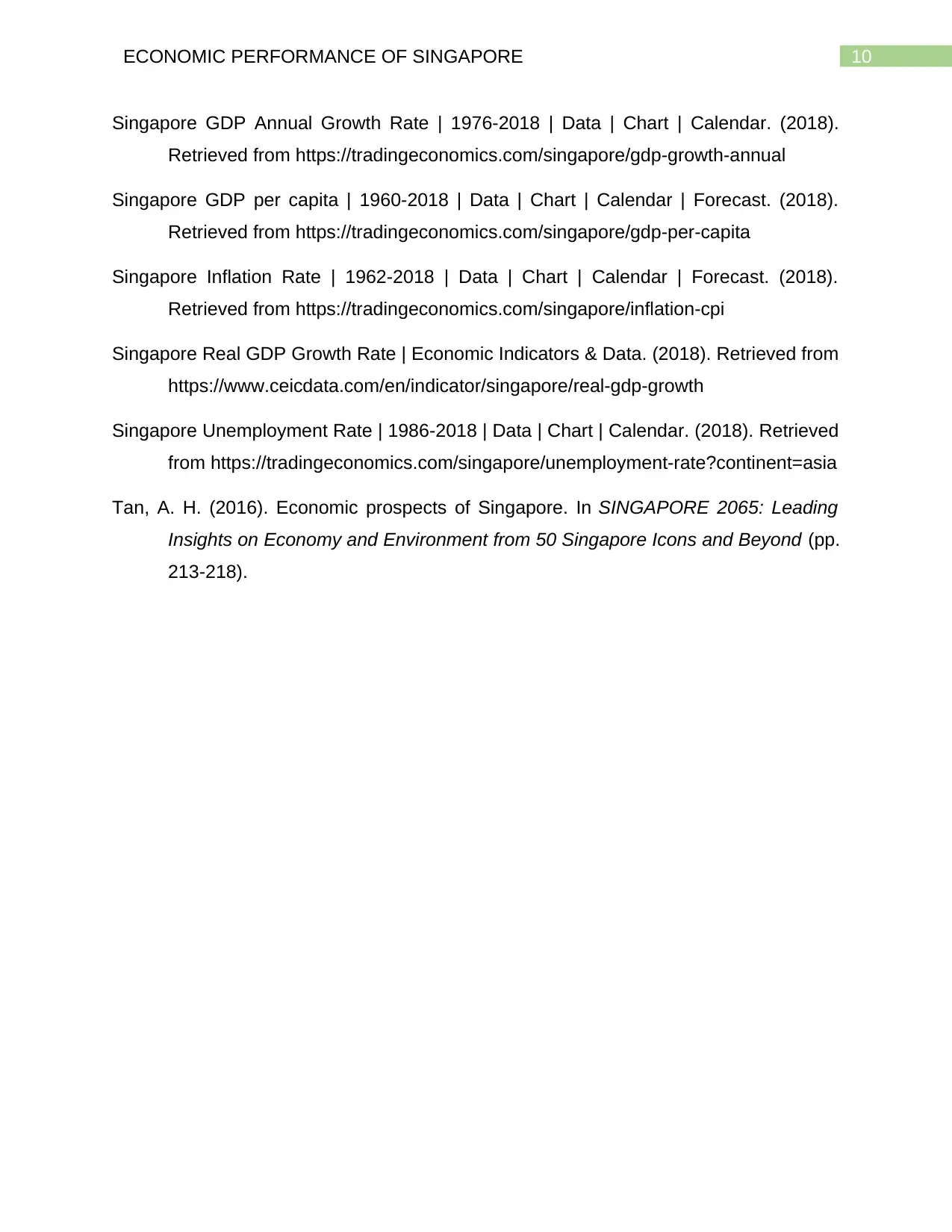
10ECONOMIC PERFORMANCE OF SINGAPORE
Singapore GDP Annual Growth Rate | 1976-2018 | Data | Chart | Calendar. (2018).
Retrieved from https://tradingeconomics.com/singapore/gdp-growth-annual
Singapore GDP per capita | 1960-2018 | Data | Chart | Calendar | Forecast. (2018).
Retrieved from https://tradingeconomics.com/singapore/gdp-per-capita
Singapore Inflation Rate | 1962-2018 | Data | Chart | Calendar | Forecast. (2018).
Retrieved from https://tradingeconomics.com/singapore/inflation-cpi
Singapore Real GDP Growth Rate | Economic Indicators & Data. (2018). Retrieved from
https://www.ceicdata.com/en/indicator/singapore/real-gdp-growth
Singapore Unemployment Rate | 1986-2018 | Data | Chart | Calendar. (2018). Retrieved
from https://tradingeconomics.com/singapore/unemployment-rate?continent=asia
Tan, A. H. (2016). Economic prospects of Singapore. In SINGAPORE 2065: Leading
Insights on Economy and Environment from 50 Singapore Icons and Beyond (pp.
213-218).
Singapore GDP Annual Growth Rate | 1976-2018 | Data | Chart | Calendar. (2018).
Retrieved from https://tradingeconomics.com/singapore/gdp-growth-annual
Singapore GDP per capita | 1960-2018 | Data | Chart | Calendar | Forecast. (2018).
Retrieved from https://tradingeconomics.com/singapore/gdp-per-capita
Singapore Inflation Rate | 1962-2018 | Data | Chart | Calendar | Forecast. (2018).
Retrieved from https://tradingeconomics.com/singapore/inflation-cpi
Singapore Real GDP Growth Rate | Economic Indicators & Data. (2018). Retrieved from
https://www.ceicdata.com/en/indicator/singapore/real-gdp-growth
Singapore Unemployment Rate | 1986-2018 | Data | Chart | Calendar. (2018). Retrieved
from https://tradingeconomics.com/singapore/unemployment-rate?continent=asia
Tan, A. H. (2016). Economic prospects of Singapore. In SINGAPORE 2065: Leading
Insights on Economy and Environment from 50 Singapore Icons and Beyond (pp.
213-218).
1 out of 11
Related Documents
Your All-in-One AI-Powered Toolkit for Academic Success.
+13062052269
info@desklib.com
Available 24*7 on WhatsApp / Email
![[object Object]](/_next/static/media/star-bottom.7253800d.svg)
Unlock your academic potential
Copyright © 2020–2026 A2Z Services. All Rights Reserved. Developed and managed by ZUCOL.



